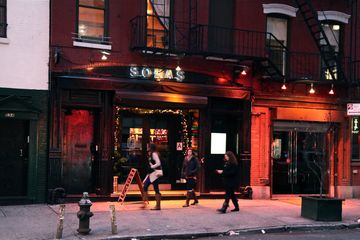Copacabana originally opened in 1940 and would eventually welcome notable performances from the likes of Frank Sinatra, Dean Martin, Sammy Davis Jr, The Supremes, The Temptations, Marvin Gaye, and Sam Cooke — several of whom would go on to record live albums at the venue. The iconic nightclub was one of the early victims of the pandemic and closed its Times Square location on 8th Avenue and W47th Street in May 2020. But music and passion has brought longtime Copacabana owner John Juliano and nightlife impresario Ruben Rubin Cabrera together for a triumphant return of The Copacabana. After founding owner Jules Podell died in 1973, the club shut down for several years, reopening in 1976 under the leadership of Juliano. The serial nightclub owner told W42ST while sitting at a booth in a midtown diner: “It was my pet, the Copacabana was my pet and still is. ” He rebuilt an environment where “people started coming in from the old days — Desi Arnaz, Frank Sinatra, Tony Bennett — I met all of those people, ” says Juliano. This melding of 40s Golden Age mystique and 70s hazy, boisterous discotheque was forever immortalized in Barry Manilow’s 1978 smash-hit Copacabana (At the Copa). The song, a fictional, three-act tale of one showgirl’s descent into madness over her murdered lover, hit the Billboard Top Ten in 1978 and would go on to be adapted into a full-length TV movie musical and cult hit stage production. It was within this world of glitz, glamor, and Copacabana showgirls that Cabrera first fell in love with nightlife. He grew up in Hell’s Kitchen and found himself working as a teenager at a catering hall on East 60th Street in 1979. The owner used to go to the Copa on Tuesday nights, “and one Tuesday he invited me to go with him. “He said, ‘Let me take you downtown and show you the real club scene’, ” Cabrera recalls. He was only 14, “I was a tall, skinny kid who looked older than I was, ” and the owner “bought me my first suit” to wear to the club. Cabrera put on the suit and snuck into the Copa, where he was smitten by the big band and the bright, noisy, world of nightlife. “The Copa girls were my first love — I fell in love with them, I fell in love with the bartender, I fell in love with the club scene and I have been in it ever since. ”Cabrera had been running the venue as Casa 51 up to the onset of COVID, now he’s thrilled to be bringing the vibrant energy of the Copa back to Hell’s Kitchen. “I grew up spending a lot of time going to every bar and restaurant in Times Square and Hell’s Kitchen, and spending lots of sleepless nights here, ” he saysDuring his over 45 year tenure, Juliano has run nightclubs throughout Hell’s Kitchen including Copacabana venues on 11th Avenue at W34th and W57th Street as well as the famed Red Parrot and Emerald City. He hosted the Copa’s most recent location in Times Square, where he expanded the club’s reach by positioning it close to bustling tourist hotspots. A stroke and the COVID-19 shutdown forced him to step back, but he has since recovered and is excited to bring back “Latin dancing — there’s no place to go to do salsa and merengue, this will be it. ”This story was adapted from the W42ST article, "The Copacabana Returns to New York in a Glittering Disco Revival — Who Could Ask for More? ”

